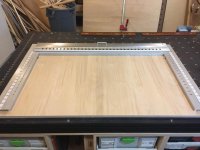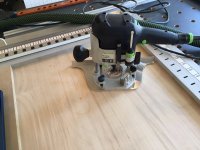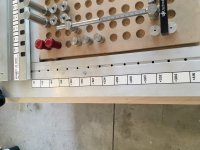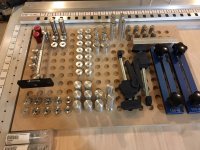Bugsysiegals
Member
- Joined
- Mar 19, 2016
- Messages
- 908
I’ll be using my LR32 in the near future and hadn’t considered making any jigs to simplify things but this thread has me thinking ...
I was considering mounting the holy rail to my Incra fence rails, zeroing out the magnetic scale, drilling the first holes at 37mm, zeroing the scale again, and then easily moving the fence in precise increments of 32mm. While this could work well, assuming I can print some mounts and get things to stay square, I thought about another idea ...
I like the idea of using the MFT/3 with its 96mm spacing which is divisible by 32mm. I’m thinking I can replace the regular rail with the holy rail (since it’s 55” I’d buy an extra swivel and mount it so the regular rail and holy rail could easily be swapped), raise it up just above the material, square it with dogs/triangle, and clamp the front raiser. I’d then space some dogs in the holes in front of the fence and keep the material pushed up against the dogs. I’d then put dogs parallel with the fence and keep the material pressed to it. Holes would be drilled, the board would be moved Right, dogs moved Right, and more holes drilled. This seems rather easy but would require a few things ...
The holy rail would have to be aligned Left/Right so that the router bit lands on 37mm from the front of the board with the board butted up against the vertical dogs. Since the Left/Right position is arbitrary it seems this could be set and used for regular cutting as well as for making shelf pin holes. The next thing would be the fence would need to be aligned Front/Back so the holes have the correct offset in relationship to the Top/Bottom of the board which is pushed up to the horizontal dogs in front of the fence. This is also adjustable to some degree and I assume is feasible. Other than aligning the holy rail, it seems you may want 2x 32mm width boards in case you desire some holes which don’t fall on increments of 96mm. If your offset from the Top/Bottom of the board always stays the same, it seems this would be very repeatable and is easily adjustable for various board thicknesses...
I was considering mounting the holy rail to my Incra fence rails, zeroing out the magnetic scale, drilling the first holes at 37mm, zeroing the scale again, and then easily moving the fence in precise increments of 32mm. While this could work well, assuming I can print some mounts and get things to stay square, I thought about another idea ...
I like the idea of using the MFT/3 with its 96mm spacing which is divisible by 32mm. I’m thinking I can replace the regular rail with the holy rail (since it’s 55” I’d buy an extra swivel and mount it so the regular rail and holy rail could easily be swapped), raise it up just above the material, square it with dogs/triangle, and clamp the front raiser. I’d then space some dogs in the holes in front of the fence and keep the material pushed up against the dogs. I’d then put dogs parallel with the fence and keep the material pressed to it. Holes would be drilled, the board would be moved Right, dogs moved Right, and more holes drilled. This seems rather easy but would require a few things ...
The holy rail would have to be aligned Left/Right so that the router bit lands on 37mm from the front of the board with the board butted up against the vertical dogs. Since the Left/Right position is arbitrary it seems this could be set and used for regular cutting as well as for making shelf pin holes. The next thing would be the fence would need to be aligned Front/Back so the holes have the correct offset in relationship to the Top/Bottom of the board which is pushed up to the horizontal dogs in front of the fence. This is also adjustable to some degree and I assume is feasible. Other than aligning the holy rail, it seems you may want 2x 32mm width boards in case you desire some holes which don’t fall on increments of 96mm. If your offset from the Top/Bottom of the board always stays the same, it seems this would be very repeatable and is easily adjustable for various board thicknesses...




